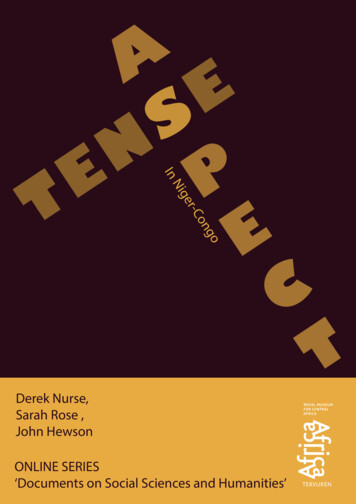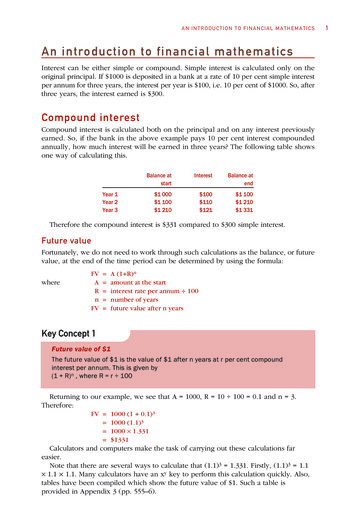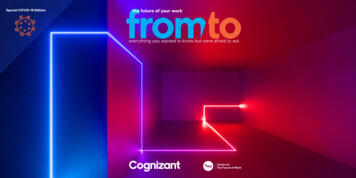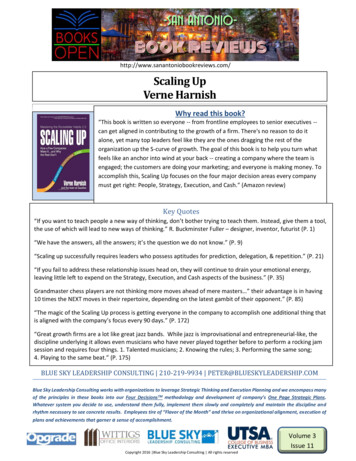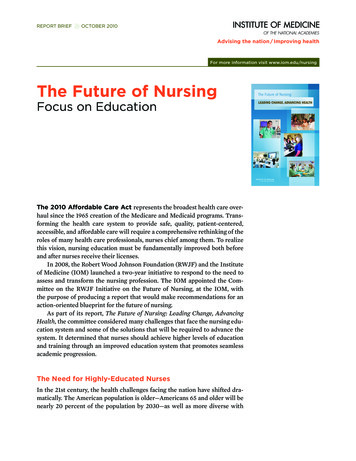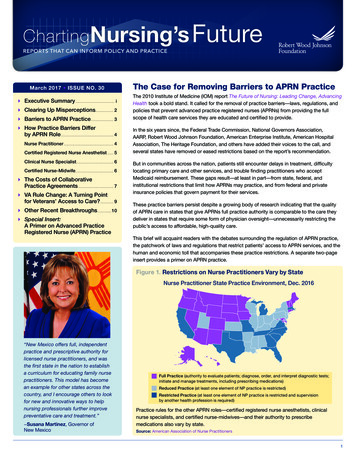
Transcription
M EDICAL S CHOOLYour Future inMedicine, Today
Table of ContentsOn the cover: Students mingle on the Dr. DonaldSeldin Plaza. Located in the heart of UT SouthwesternMedical Center’s South Campus, the Plaza wasnamed in honor of Donald W. Seldin, M.D., an iconof American academic medicine and the intellectualfather of UT Southwestern.Why UT Southwestern01Student Life02Student Diversity, Inclusion, and Equity03Combined Degree Programs04Medical Scientist Training Program05Our Curriculum06Academic Colleges07Explore Careers in Medicine08Pre-Clerkship09Community Service Opportunities10Clerkship11Post-Clerkship13Clinical Training Facilities15Research Opportunities to Supplement Your Training17Dallas/Fort Worth18Cost and Financial Support19Questions? Contact Us19
the biomedical sciences Elite clinical training in a variety of settings– including one of the nation’s leading publichospitals A supportive campus community of students,faculty, and administrators who are ready toprovide students with the tools to achieve asustainable and fulfilling career in medicineOur Office of Student Affairs partners withStudent Life, Student Academic SupportServices, and the Student Counseling andWellness Center to support students throughouttheir time here while equipping them withtools necessary to lay the foundation forsustainable careers in medicine that alignwith their values. We embody this goal byfostering and expanding our offerings forstudent life programs, including: H igh-quality, medical education grounded inStudent LifeUT Southwestern students hail from all backgrounds,and their unique experiences and influences enrichcampus life. UT Southwestern Medical School uses aninnovative curriculum and early clinicalexperiences in some of the nation’s mostdynamic health care facilities to train thephysicians of tomorrow. Each year at UTSouthwestern, roughly 230 studentsbegin training under the guidance of ourrenowned faculty with access to richlydiverse clinical opportunities and studentcentered learning communities.Few medical schools nationally can match the overalleducational excellence UT Southwestern offers in itsclassrooms, laboratories, clinics, and hospitals, at anunparalleled cost of tuition. Our promise to studentsis to provide them with:UTSW students leap into volunteering opportunities, ashere, at the United to Serve health fair, held annuallyat T.J. Rusk Middle School in Dallas to benefit the surrounding community with free screenings and healthinformation. Why UT SouthwesternGame on! Students play dodgeball during PRE OP(Preregistration Education and Orientation Program)weekend. Held a few days prior to the start of classes,this overnight retreat allows first-year students toget to know their classmates in a fun setting. 100 registered student groups on campus Intramural sports leagues M indfulness classes O pportunities for students to engage and servethe local Dallas community Fitness classes and workout facilities Wellness resources Robust academic support resources Meet the Deans social events to get to knowstudents personally and build community Weeklong MS1 Orientation: Southwestern Styleand PRE OP (orientation weekend retreat) STRIVE: Personal and Professional Developmentfor Careers in Medicine seminar course White Coat ceremony Match Day Brunch and Celebration Hooding and � One of the principal reasons that I decided to attendUT Southwestern was the support provided by facultyand mentors. The clinicians and administratorsgenuinely care about each student’s well-being, and thishas been evident since my very first day on campus.”– Bethany Werner, Class of 2019 Pediatrics Associate Professor Dr. Elizabeth Stehel(right) demonstrates the gentle art of thenewborn exam for medical students at the ParklandHospital nursery.02
Combined Degree ProgramsAlong with the M.D. degree, UT Southwestern MedicalCenter offers many opportunities for students toexplore areas of interest that align with their valuesand career aspirations. Explore the range of optionsthat could comprise the foundation of your future inmedicine here.M.D./M.S.: This program combines rigorous didactictraining with a mentored clinical research project. Theprogram concludes with submission and defense of amaster’s thesis. (utsouthwestern.edu/mdms)M.D./M.B.A.: This five-year program focuses ongiving future physicians the skill sets for successfullyintegrating medicine and business. (utsouthwestern.edu/md-mba)M.D./M.P.H.: Students interested in studying medicineand public health can be awarded a degree in each fieldat the end of a four-year program. (utsouthwestern.edu/md-mph)“ I chose UT Southwestern because I knew itwould offer the best educational experience.I feel myself becoming more and more of thephysician I wish to be each day I spend here.”Graduation DistinctionsStudents have the opportunity to graduate with an M.D.with Distinction in multiples areas, including research,community health, global health, medical education,and quality improvement and patient safety.– Max Magallanes, Class of 2019Diversity and inclusion are essential for all studentsto achieve their full potential.At UT Southwestern, the Office of Student Diversityand Inclusion enhances diversity education andfosters a culture of inclusion in our student bodythrough a variety of programs to identify and recruitexceptional students.03The Office of Student Diversity and Inclusion is here toserve as a resource for students – helping ensure theyget the most out of their medical school experiencewhile reaching the highest levels of excellence.Through an open-door policy, a commitment tostudents and cultural awareness, academic/socialactivities, mentoring programs, and active supportof diverse student organizations, our students builda strong foundation for success.utsouthwestern.edu/student-diversityDr. Reeni Abraham, Co-Director of the Internal MedicineClerkship (right), preps her student ward team beforevisiting patient rooms. Student Diversity, Inclusion,and Equity utsouthwestern.edu/degrees-distinctionsDog day afternoon. UTSW students decompress from thedemands of medical school by visiting with a registeredtherapy dog, one of many student wellness initiativeson campus.
Our overarching goal as a medical school is ensuringthat each of our students is intellectually and personallychallenged to be the best physician possible. 1 8 months of introductory courses dealing withthe biology of disease, followed by clinical clerkshipsthat introduce the student to the bedsideThis vision is what drives our new and excitingcurriculum that has built-in opportunities for growthin diverse areas, combined with novel career opportunities that excite and inspire. Our curriculum providesstudents with a strong foundation in the biomedicalsciences, exceptional – and early – training in clinicalcare, and abundant research opportunities. A n average of four years of graduate study anddissertation research in an area of basic biomedicalscience, leading to the Ph.D. degreeschool, leading to the M.D. d-school/curriculum “Our program is distinctive because it providesparticipants with topnotch clinical trainingand with mentoring byworld-class scientists ina highly collaborative,nurturing environment.”Internal Medicine Professor Dr. Biff Palmer has receivednumerous teaching awards at UT Southwestern. He hasalso climbed the highest peaks on every continent.Curriculum Timeline at a GlanceAbbreviations:BSFBody Structure FoundationsFBSFundamentals of Biomedical SciencesFCRFoundations of Clinical ReasoningTCTransitions to ClerkshipFiMFrontiers in MedicinePSPhysicians and SocietyREResidency EssentialsF O U N D AT I O N F O R E X C E L L E N C E CU R R I CU LU MCLERKSHIPAcademic Colleges (Weekly)Academic Colleges (Monthly)USMLE Prep(6 Weeks Total)Clinic Core Blocks (48 Weeks Total)Scholarly ActivityFiMGrowth and ExplorationG raduationFC RG&EPSREFBSIntegrated Medicine:Health to DiseaseFiMBSFTCSTRIVEScholarly Activity (12 Weeks Total)Abbreviations: BSF Body Structure Foundations FBS Fundamentals of Biomedical Sciences FCR Foundations of Clinical ReasoningJUNMAYAPRMARFEBJANNOVOC TSEPAUGJULYEAR 4JUNJANDECNOVOC TSEPAUGJUNJULMAYAPRYEAR 3MARFEBJANDECNOVOC TSEPAUGJULJUNMAYAPRYEAR 2MARFEBJANDECNOVOC TSEPAUGJULYEAR 1P O S T- C L E R K S H I PDECPRE-CLERKSHIP– Andrew Zinn, M.D., Ph.D., Dean,UT Southwestern Graduate SchoolMAYCarlos Paz conducts research in the O’Donnell-Mendelllab, which is focused on understanding the mechanisms that contribute to tumor initiation, progression,and metastasis.APR C linical studies in the final two years of medicalMARAt UT Southwestern, we’re preparing tomorrow’sphysicians and training the scientists who will convertlaboratory research into disease cures. One of fewerthan 50 M.D./Ph.D.-granting programs with financialsupport from the NIH, the MSTP program providesphysician-scientists a rigorous but supportive programof clinical and research training.Our Curriculum: YourFoundation for ExcellenceEach year, 10 outstanding students from across thecountry and around the world are selected for theMSTP program. The highly competitive curriculumconsists of:FEBMedical Scientist TrainingProgram (MSTP) –M.D./Ph.D. Program
Academic Colleges: Community,Faculty Mentorship, andProfessional Clinical SkillsTraining – Beginning Day 1“ When I applied to medical school, I thought that high-qualityeducation and effective student wellness promotion weremutually exclusive – that you couldn’t train at a world-classAcademic Colleges are small, student-centered learningcommunities that bring together experienced facultyleaders with small groups of six students to learnprofessional clinical skills, behaviors, and attitudesof a highly experienced physician.institution AND find a supportive community among bothstudents and faculty. UT Southwestern proved me wrong.”–Reilly Alex Sample, Class of 2021Students are assigned to one of the six Colleges on theirfirst day of medical school and remain in their Collegefor all four years of their education – including weeklymeetings with faculty mentors for the first 18 months.The weekly clinical sessions in your Academic Collegewill integrate with and complement your courseworkand provide personalized instruction in such topicsas interviewing and examining patients, developingclinical reasoning skills, and more.utsouthwestern.edu/academic-collegesOur whole program is founded on a commitmentto treating each student as a unique member ofa learning community, providing all students withmentoring by faculty, enhanced opportunities foractive learning, and a curriculum that encouragesthe pursuit of individualized pathways. Held a few days prior to the start of classes, PRE OP(Preregistration Education and Orientation Program)weekend is an overnight retreat where first-year studentsget to know their classmates in a fun setting and bondwith the new Academic College peers they’ll have for thenext four years. The six Academic Colleges pair studentswith physician mentors whose guidance and insight intobeing a real doctor transcend textbooks and make theUT Southwestern Medical School experience like none other. Small-group College sessions give students theopportunity to work and learn collaboratively.08Explore Careers in MedicineUT Southwestern has many programs and initiativesin place to encourage students to consider variouscareers in medicine and choose which might be bestfor them. During the first-year orientation, studentsare introduced to faculty members who represent thevarious clinical departments as specialty advisors andare provided with workshops and assessments to helpthem explore the possibilities.Opportunities are available for students to learn moreby attending the STRIVE job talks provided by eachclinical specialty throughout the first 18 months orby joining one or several Specialty Interest Groups,which are student-led and faculty-sponsored studentorganizations. These groups typically provide noonsessions where students can learn more about theparticular field, offer shadowing opportunities, andpractice skills such as suturing, casting, and performingspecialty physical exams. Many of these groups havecommunity outreach activities as well.08
Pre-ClerkshipKnowledge Building in Basic andClinical SciencesThe first year and a half of medical school is focusedon building knowledge in basic and clinical sciencesthrough rich, team-based learning experiences in theclassroom, laboratories, state-of-the-art simulationcenter, and student-centered learning environmentssuch as the Team-Based Learning Center.The Team-Based Learning Center is a 4 million facilitythat can seat up to 240 students at its 40 tables, eachtable with its own video screen. The room can support960 wireless connections.Strong Foundation in BasicBiomedical SciencesDuring the Pre-Clerkship period, students gainimportant scientific knowledge, attitudes, and skills,as well as a common vocabulary shared by the medicalprofession. You’ll study the fundamentals of biomedicalsciences, body structure foundations, integratedmedicine from health to disease, the foundations ofclinical reasoning, and the requisites for effectivelytransitioning to the clinical clerkships – all of which arevital elements in building a foundation for ve LearningOur Medical School curriculum emphasizes theimportance of active learner engagement throughoutthe curriculum. Students will learn in small-group,team-based learning, and “flipped classroom” teachingmodalities, in addition to training in our state-ofthe-art simulation center. To support collaborationand ease the transition into medical school, all classesduring the Pre-Clerkship period are pass/fail to allowstudents more space to concentrate on learning in ateam-oriented environment.Community ServiceOpportunitiesStudents have the opportunity to utilize their clinicaltraining and engage with patients outside the clinicthrough numerous community engagement eventsthroughout the year.Community outreach events include United to Serve(an annual health and fun fair hosted by UT Southwestern for the surrounding community), Hepatitis BFree, STD lectures, Fit for Health, and more. Our community outreach events provide patients with healtheducation, critical health screenings, and referrals toconnect patients with ongoing care that they may nototherwise have access to.Student-run free clinics include the Monday Clinic,Calvert Place and Center of Hope, Agape Clinic, andmore. Student-run clinics allow medical students toprovide care to the underserved while being supervisedby UT Southwestern physicians.utsouthwestern.edu/ms-community-service UTSW students benefit from training in one of themost advanced simulation centers in the country. Team-based learning encourages accountability forthe quality of individual and group work.09Your medical education will comprise threedistinctive periods: Pre-Clerkship, Clerkship,and Post-Clerkship, each of which offersdifferent but complementary experiences.10
Exploring Clinical Fields While PromotingScientific Inquiry and Lifelong LearningThe Clerkship period starts in the middle ofyour second year and continues over the next 18calendar months.This early start in clerkships is designed to give you theopportunity to explore more clinical fields to help youdecide on your ultimate career specialty.During this period, you’ll complete 48 weeks of clerkshiprotations in internal medicine, surgery, pediatrics,obstetrics and gynecology, psychiatry, neurology,family medicine, and ambulatory care.Scholarly Activity – You ChooseYour Area of ResearchThe Clerkship period includes six weeks of electivesand 12 weeks devoted to a required Scholarly Activityin a particular concentration based on your ownpriorities and interests.You choose the subject of your work within varioustracks, including basic research, clinical and translational research, quality improvement, communityhealth, global health, and medical education.Designed to direct your path as a lifelong learner, theScholarly Activity will build your analytical and communication skills and enhance self-directed learningcapabilities.Time to Prep for the USMLEDuring the Clerkship period, students participate ina six-week course that helps prepare them for theimportant United States Medical Licensing Examination(USMLE) Step 1. The course provides structure tostudents’ preparation, study materials and questionbanks to promote success, and an opportunity tomonitor progress and provide support as needed.11Your Professional Development ContinuesThe Academic Colleges continue throughout theClerkship and Post-Clerkship periods, with your smallgroup meeting monthly with your mentor to exploresuch topics as ethics, professionalism, health systems,quality improvement, personal wellness, and clinicalreasoning. This longitudinal relationship with yourmentor throughout your medical education allows forongoing professional development, personal careeradvising, and the opportunity for reflection whencritical moments occur during your training.utsouthwestern.edu/ms-clerkship ClerkshipUTSW students provide care at Children’s Medical Center,the primary pediatric teaching hospital for UT Southwestern and one of the top-ranked pediatric hospitals inthe country.Surgical oncologist Dr. Rohit Sharma (second from left)guides students in the OR at UT Southwestern’s signature William P. Clements Jr. University Hospital, namedthe No. 1 hospital in Dallas/Fort Worth byU.S. News & World Report.
Residency Match RatesBecause of the exceptional trainingopportunities at our affiliated hospitalsand clinics, our students are preparedfrom the first day of their residencytraining to care for patients.UTSW students consistently match atsome of the top-ranked hospitals andprograms in the nation, includingUT Southwestern’s.Other destinations include:Harvard (Brigham and Women’sHospital, Massachusetts GeneralHospital, Boston Children’s Hospital,Beth Israel Deaconess)Stanford UniversityUniversity of California, San FranciscoUniversity of WashingtonPost-Clerkship:Your Final 12 monthsTailored Experiences Preparing Youfor Residency and BeyondDuring this time, you’ll participate in two four-weekcourses involving sub-internships, rigorous subspecialtyrotations, and critical care rotations. You’ll also have anadditional 16 weeks of elective time to build strengthsin your chosen field and complete the USMLE Step 2Clinical Knowledge and Clinical Skills exams. Inaddition, you’ll have up to eight weeks to interviewfor residency positions.13If you haven’t already done so during the Clerkshipperiod, you can use your Post-Clerkship time to completeyour 12-week Scholarly Activity. You’ll choose yourarea of interest for your study and benefit from theguidance of a faculty member throughout.Reinforcing Your Foundation inBiomedical SciencesAfter completing much of your clinical education, youwill have the unique opportunity to re-explore anddeepen your understanding of the basic, translational,and clinical sciences as a basis for evidence-basedmedical practice through a four-week Frontiers InMedicine course. Students choose from one of thefollowing themes: Healthy Aging, Neoplasia andNeoplastic Disease, Emerging Infectious Diseases,Behavioral Health and Neuromedicine, Conception,Obstetrics and Child Health, Resuscitation Medicine,or Regenerative Medicine.After four event-filled years, the nation’s newestdoctors gather for Commencement exercises at theMorton H. Meyerson Symphony Center in the Dallas ArtsDistrict, ending one chapter and beginning many more.Duke UniversityVanderbilt UniversityPreparation for Life After GraduationIn your final months, you will benefit from two specialcourses delivered concurrently over six weeks designedto prepare you for life after graduation:Physicians and Society – weaves together topics,including determinants of health, physician well-being,critical conversations, health economics, health policy,and multiculturalism for all future physicians, regardlessof residency or career path.Residency Essentials – through active learning,including multiple simulation exercises, this courseprovides core and specialty-specific preparation foryour transition from student to resident.utsouthwestern.edu/ms-post-clerkship The final portion of your time in medical school isdevoted to providing you with unique experiencesthat will enhance your preparation for residencyand beyond.Electives or Scholarly Activity of Your Choosing Washington University in St. LouisDr. Angela Mihalic, Dean of Medical Students andAssociate Dean for Student Affairs (center), congratulatesmedical students who’ve just found out where they’vematched in their respective programs.
Zale Lipshy Pavilion Parkland Hospital Children’s Medical Center Dallas VA North Texas Hospital Zale Lipshy Pavilion: A 148-bed specialty facility,Zale Lipshy is one of the world’s premier neurological diagnostic and treatment centers and a JointCommission-certified Advanced Comprehensive StrokeCenter. Offering cutting-edge imaging with a 320-sliceCT scanner and 3T MRI, Zale has the highest-rankedneurology and neurosurgery programs in North Texas.Texas Health Presbyterian HospitalParkland Health & Hospital System: Averaging morethan 1 million patient visits annually, Parkland isone of the nation’s busiest public hospitals. Newly builtin 2015 and holding 870 beds, Parkland is where ourstudents receive 80 percent of their clinical training,and thus, a vital part of our medical students’ clinicalexperience.“Getting to learn in the different environmentsof Parkland and Clements is invaluable, andI know I’ll graduate with some of the best clinical training in the nation.” William P. Clements Jr. University HospitalClinical Training FacilitiesWilliam P. Clements Jr. University Hospital: Oursignature 12-floor, 460-bed, state-of-the-art facilitysets the standard for what an academic medical centercan and should be. CUH, which opened in 2014, isthe embodiment of UT Southwestern’s three-partmission of providing top-echelon education, research,and patient care.UT Southwestern University Hospitals collectively havebeen ranked by U.S. News & World Report as theNo. 1 Best Hospital in Dallas-Fort Worth and theNo. 2 Best Hospital in Texas. During their training, M.D. students master15clinical skills and develop compassionfor and commitment to their patients.Children’s Medical Center: A private, nonprofitinstitution and the primary pediatric teaching hospitalfor UT Southwestern, Children’s has 490 beds and alsohouses more than 50 specialty clinics.– Rachel Hurst, Class of 2020Veterans Affairs North Texas Health Care System:The U.S. Department of Veterans Affairs’ second largesthealth care system, the Dallas VA Medical Center serves38 Texas counties and two counties in southern Oklahoma, providing primary, tertiary, and long-term care.Texas Health Presbyterian Hospital Dallas: Part ofthe Texas Health Resources (THR) system, this 888-bedacute care facility is affiliated with UT Southwesternthrough a clinically integrated health care networkcalled Southwestern Health Resources, which linksUTSW and THR. The affiliation expands the number ofclinical training sites and clinical training opportunities in primary care.utsouthwestern.edu/ms-clinical-training
Research Opportunities toSupplement Your TrainingUT Southwestern is one of the world’s foremostresearch institutions and leads the way in scientificdiscovery. Currently, we have thousands of researchprojects underway with nearly 455 million in annualfunding. According to the Nature Index 2018 AnnualTables, UTSW is ranked first globally within the“healthcare” category for publishing high-qualityscientific research. We’ve made breakthrough discoveries in many areas of medicine, including cardiology,cancer, the neurosciences, cholesterol, metabolism,diabetes, genetics, and the immune system.You’ll have ample opportunities to participate inresearch, including the Medical Student SummerResearch Program prior to or following your first yearand the Scholarly Activity of your choice that startsduring your Clerkship period. With multiple ScholarlyActivity tracks available and more than 450 labs oncampus, research possibilities will always be at yourfingertips.And if you want to do even more, we have additionalprograms that will accommodate and fulfill yourinterests, such as:Elective and Yearlong ResearchAdditional research opportunities are availablethrough four-week electives offered in the Clerkshipand Post-Clerkship periods. Students are also encouraged to explore yearlong research programs in basicor clinical research. National research programs, suchas those supported by the Howard Hughes MedicalInstitute and by the Sarnoff Foundation, representprograms that afford comprehensive research trainingin a variety of disciplines.Dallas/Fort WorthUT Southwestern is located in the heart of one of themost dynamic areas of the country. The Dallas/FortWorth Metroplex is a contemporary, exciting area witha diverse population featuring various neighborhoodsthat play home to art galleries, marketplaces, parks,community centers, co-working spaces, restaurants,theaters, and venues. It’s all here.SportsFew areas can match the endless sports excitementfound in the Metroplex, which is one of only eight U.S.metro areas with teams in all five major professionalsports: The NFL’s Cowboys, NBA’s Mavericks, MLB’sRangers, NHL’s Dallas Stars, WNBA’s Dallas Wings, andMLS’s FC Dallas.lence in cutting-edge basic science research, “ UT Southwestern has a long history of excelwhich is evident in both the strength of thenew curriculum and in the countless oppor– Jessica Fults, Class of 202118 tunities for students to engage in research.”Downtown Dallas is just minutes from the UT Southwestern campus. The Dallas/Fort Worth Metroplex is acontemporary, exciting area with a diverse populationand low cost of living. It’s also the fourth largest U.S.Metro area – and rising.MSTP student Abbee Mohan participates in the lab ofDr. Gaudenz Danuser, which focuses its research onhow chemical and mechanical signals are involved inmembrane trafficking, among other things.Vibrant Arts SceneResidents and visitors alike enjoy the city’s rapidlygrowing array of artistic possibilities. The 68-acreDallas Arts District, adjacent to Klyde Warren Park andlocated close to the UT Southwestern campus, is thelargest urban arts district in the country.Easy Access to AnywhereDallas is centrally located and within a four-hour flightfrom most North American destinations. It is servedby two airports – Dallas/Fort Worth International andDallas Love Field – that combined provide more than1,900 flights daily. AMTRAK also provides daily serviceto Dallas via Union Station.A Thriving EconomyFor over a decade, the DFW employment rate hasoutpaced the national average, almost doubling thenational mark in recent years. Dallas’ steadily risingpopulation, numerous institutions of higher education,growing economy, vibrant cultural scene, and sprawling cityscape mean there are endless opportunities foryour interests to flourish in Dallas.Low Cost of LivingThe cost of living in Dallas/Fort Worth is lower thanmany other cities of comparable size and amenities,including New York, San Francisco, Boston, Philadelphia, Los Angeles, and Chicago.
Cost and Financial SupportQuestions? Contact UsThe cost of education at UT Southwestern is substantiallylower than nearly every private medical school in theU.S., as well as most public medical schools.Admissions & RecruitmentPhone: 214-648-3606admissions@utsouthwestern.eduTuition and fees are approximately 20,000 per year.A personal computer is required of all incomingstudents and is included in financial-aid packages.UT Southwestern works directly with students toobtain funding for their medical education. Mostof the financial aid available is obtained throughfederal and state loan programs. In addition,scholarships from private sources are available.MSTP Program AdmissionsPhone: 214-648-6764Ready to apply?Applying to the Medical School at UT Southwestern requiressubmission of both a primary and secondary application: Texas Medical and Dental Schools ApplicationService (TMDSAS) U T Southwestern Admissions WebsiteApplications are accepted starting May 1 and thedeadline to submit both the TMDSAS and secondaryapplication is October 1.19Office of Student AffairsPhone: 214-648-2168Office of Student Diversity and InclusionPhone: 214-648-0308Office of Medical Student ResearchPhone: 214-648-4070Apply at: utsouthwestern.edu/med-school/admissions
AdmissionsThe University of Texas Southwestern Medical CenterOffice of Enrollment Services5323 Harry Hines Blvd.Dallas, TX 75390-9162214-648-3606Fax: 214-648-3289admissions@utsouthwestern.edu 2018 UT Southwestern Medical Center. MKT 19084utsouthwestern.edu/education/medical-school
Students interested in studying medicine and public health can be awarded a degree in each field at the end of a four-year program. (utsouthwestern. edu/md-mph) Graduation Distinctions. Students have the opportunity to graduate with an M.D. with Distinction in multiples areas, including rese




